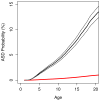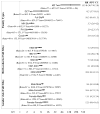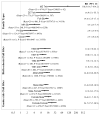The familial risk of autism
- PMID: 24794370
- PMCID: PMC4381277
- DOI: 10.1001/jama.2014.4144
The familial risk of autism
Abstract
Importance: Autism spectrum disorder (ASD) aggregates in families, but the individual risk and to what extent this is caused by genetic factors or shared or nonshared environmental factors remains unresolved.
Objective: To provide estimates of familial aggregation and heritability of ASD.
Design, setting, and participants: A population-based cohort including 2,049,973 Swedish children born 1982 through 2006. We identified 37,570 twin pairs, 2,642,064 full sibling pairs, 432,281 maternal and 445,531 paternal half sibling pairs, and 5,799,875 cousin pairs. Diagnoses of ASD to December 31, 2009 were ascertained.
Main outcomes and measures: The relative recurrence risk (RRR) measures familial aggregation of disease. The RRR is the relative risk of autism in a participant with a sibling or cousin who has the diagnosis (exposed) compared with the risk in a participant with no diagnosed family member (unexposed). We calculated RRR for both ASD and autistic disorder adjusting for age, birth year, sex, parental psychiatric history, and parental age. We estimated how much of the probability of developing ASD can be related to genetic (additive and dominant) and environmental (shared and nonshared) factors.
Results: In the sample, 14,516 children were diagnosed with ASD, of whom 5689 had autistic disorder. The RRR and rate per 100,000 person-years for ASD among monozygotic twins was estimated to be 153.0 (95% CI, 56.7-412.8; rate, 6274 for exposed vs 27 for unexposed ); for dizygotic twins, 8.2 (95% CI, 3.7-18.1; rate, 805 for exposed vs 55 for unexposed); for full siblings, 10.3 (95% CI, 9.4-11.3; rate, 829 for exposed vs 49 for unexposed); for maternal half siblings, 3.3 (95% CI, 2.6-4.2; rate, 492 for exposed vs 94 for unexposed); for paternal half siblings, 2.9 (95% CI, 2.2-3.7; rate, 371 for exposed vs 85 for unexposed); and for cousins, 2.0 (95% CI, 1.8-2.2; rate, 155 for exposed vs 49 for unexposed). The RRR pattern was similar for autistic disorder but of slightly higher magnitude.We found support for a disease etiology including only additive genetic and nonshared environmental effects. The ASD heritability was estimated to be 0.50 (95% CI, 0.45-0.56) and the autistic disorder heritability was estimated to 0.54 (95% CI, 0.44-0.64).
Conclusions and relevance: Among children born in Sweden, the individual risk of ASD and autistic disorder increased with increasing genetic relatedness. Heritability of ASD and autistic disorder were estimated to be approximately 50%. These findings may inform the counseling of families with affected children.
Conflict of interest statement
There is no conflict of interest for any of the authors.
Figures



Comment in
-
The genetic and environmental contributions to autism: looking beyond twins.JAMA. 2014 May 7;311(17):1738-9. doi: 10.1001/jama.2014.3554. JAMA. 2014. PMID: 24794365 No abstract available.
-
Recurrence rates in autism spectrum disorders.JAMA. 2014 Sep 17;312(11):1154-5. doi: 10.1001/jama.2014.9841. JAMA. 2014. PMID: 25226485 No abstract available.
-
Recurrence rates in autism spectrum disorders--reply.JAMA. 2014 Sep 17;312(11):1155. doi: 10.1001/jama.2014.9847. JAMA. 2014. PMID: 25226487 No abstract available.
References
-
- Hollander E, Kolevzon A, Coyle JT. Textbook of Autism Spectrum Disorders. American Psychiatric Pub; 2010.
-
- Bailey A, Le Couteur A, Gottesman I, et al. Autism as a strongly genetic disorder: evidence from a British twin study. Psychol Med. 1995;25(1):63–77. - PubMed
-
- Steffenburg S, Gillberg C, Hellgren L, et al. A twin study of autism in Denmark, Finland, Iceland, Norway and Sweden. J Child Psychol Psychiatry. 1989;30(3):405–416. - PubMed
Publication types
MeSH terms
Grants and funding
LinkOut - more resources
Full Text Sources
Other Literature Sources
Medical

